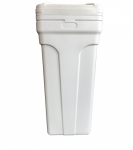If you've ever wondered what goes on inside a water softener brine tank during regeneration, you're not alone. The brine cycle is the backbone of the softening process — where sodium meets science. In simple terms, the brine cycle is the stage in water softener regeneration where a salt solution recharges the resin beads that remove hardness minerals from your water.
But how does this process actually work? And what impact does it have on the life of your system?
Let's break it down — step by step.
Why Is the Brine Tank Isn't Just a Salt Holder?
It might look like a passive container, but the water softener brine tank plays an active, chemical role during regeneration. It stores and dissolves salt (usually sodium chloride) into water, creating a concentrated brine solution. This brine is drawn into the water softener tank during regeneration to displace calcium and magnesium ions from the resin beads.
Here's why it matters:
- If the brine concentration is off, your resin won't regenerate effectively.
- Poor brine draw leads to incomplete ion exchange — and hard water at your tap.
What Really Happens: Brine Cycle Mechanics, Stage by Stage
Let's dive into what actually happens in the brine tank and connected components during each regeneration phase.
- Brine Fill and Salt Dissolution
This phase sets the stage for everything that follows. Water flows into the brine tank to dissolve salt and prepare a concentrated solution.
- Key Point: The timing and volume of this fill directly influence brine strength.
- Key Point: Too little or too much water throws off the sodium chloride concentration.
- Brine Draw: The Core Exchange Begins
During this stage, the system draws the salty brine into the resin tank. Here, sodium ions displace the calcium and magnesium ions attached to the resin beads — the very process that “resets” your softener.
- Key Point: Brine is pulled using a venturi or eductor — no pumps needed.
- Key Point: A slow, steady draw ensures full resin regeneration.
The Slow Rinse Phase: Why It Matters More Than You Think
Once the brine has passed through the resin, the system doesn't stop. It enters a slow rinse phase using fresh water. This step is critical because it clears out the displaced hardness ions and any residual brine from the resin bed.
If skipped or rushed, your water could remain salty — or worse, partially hard.
Backwash: The Forgotten Stage That Saves Your Resin
Before and after the brine cycle, the system initiates a high-flow backwash. It lifts and expands the resin bed, flushing away sediment, iron, and other trapped particles.
You might not see it, but this keeps the resin clean and extends system life.
3 Essential Things to Keep in Mind
- Resin lifespan depends on proper brine cycles. Skipping or shortening them reduces exchange capacity.
- Salt quality matters. Low-grade salts can cause bridging and clogging, hurting brine draw.
- Routine inspection of the brine tank ensures consistent system performance.
How It All Affects System Performance and Efficiency?
A well-functioning brine cycle keeps your water softener tank running efficiently and protects your investment. Without complete regeneration, resin beads lose capacity, leading to hard water leaks and premature system fatigue. Over time, that means more maintenance — and less effective softening.
Wondering If Your Brine Cycle Is Working Right?
If you've noticed fluctuating water softness or increased salt use, your regeneration cycle may be off. A water treatment technician can inspect, calibrate, or reprogram your softener for optimal brine flow and performance.
At the core of every high-performing system is precision — and that starts in the brine tank.
Need Help with Softener Performance?
Whether you're a homeowner managing well water or a facility operator overseeing large-scale treatment, understanding how the brine cycle works helps you make smarter maintenance choices regarding your water softener brine tank.
If you're using advanced, expert-engineered water treatment systems — your brine tank is doing more than you think.
Let it work smarter — so your entire water system stays stronger.






